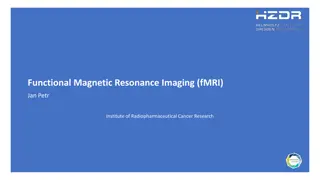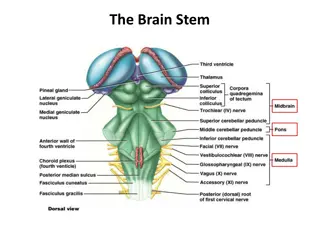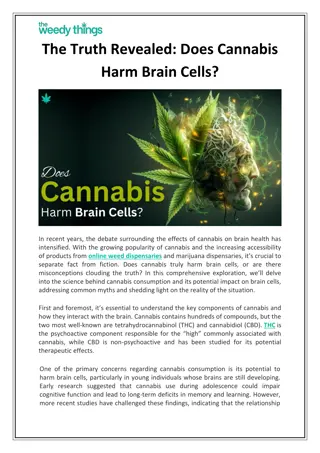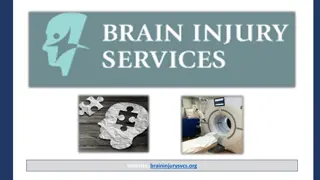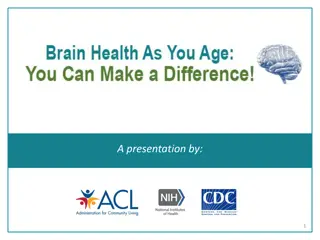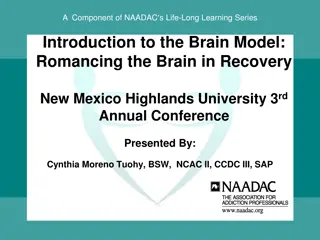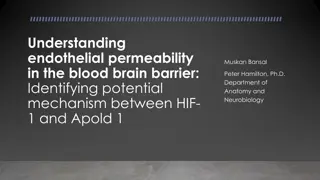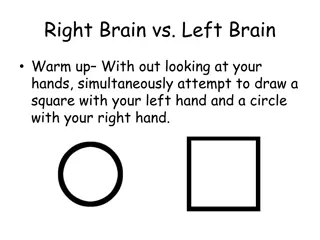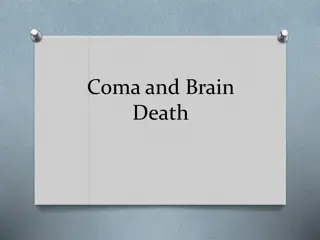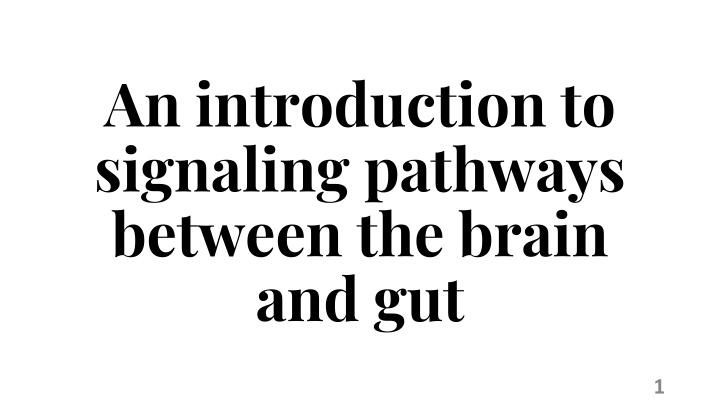
Unveiling Signaling Pathways Between Brain and Gut
Delve into the intricate connections between the brain and gut through a comprehensive video series exploring historical understandings, the blood-brain barrier, and the vital role of gut microbiota in influencing brain health. Discover why the brain was once thought to be immune-privileged and the evolving perspectives on this crucial connection.
Download Presentation

Please find below an Image/Link to download the presentation.
The content on the website is provided AS IS for your information and personal use only. It may not be sold, licensed, or shared on other websites without obtaining consent from the author. If you encounter any issues during the download, it is possible that the publisher has removed the file from their server.
You are allowed to download the files provided on this website for personal or commercial use, subject to the condition that they are used lawfully. All files are the property of their respective owners.
The content on the website is provided AS IS for your information and personal use only. It may not be sold, licensed, or shared on other websites without obtaining consent from the author.
E N D
Presentation Transcript
An introduction to signaling pathways between the brain and gut 1
Overview of the video series 1. Introduction to video series & historical understanding of brain physiology 2. Overview of BBB structure & mechanisms of blood-brain barrier (BBB) transport 3. Introduction to the gut microbiota & how these microbes influence host health e.g., = example i.e., = in other words 2
Important questions that you could answer by the end of this video series 1. Why is the brain described as an immune-privileged organ? 2. What is the BBB? What are the different mechanisms that facilitate BBB transport? 3. What are the two primary pathways that gut microbes can communicate with the brain? 4. Why are gut bacteria essential for normal brain development? 5. Why is the vagus nerve implicated in Parkinson s disease pathology? 3
Historical understanding of brain physiology 4
Why is historical context important? Scientists who discovered and proposed the existence of the BBB are often misidentified Scientists struggle to describe the mechanisms which mediate the movement of molecules from the blood to brain i.e., the central nervous system is still described as impenetrable, despite the necessity of molecules to cross the BBB for survival This misconception has historical roots The mechanism utilized to cross the BBB affects tissue specificity of a drug (discussed in the second video of this series) The idea that changes in the gut can lead to changes in the brain is very new We are still discovering pathways of the gut-brain axis, and trying to understand the importance of the gut microbiota 5
We used to think the brain was an immune-privileged organ It was thought the brain could only respond to sensory signals through nerves e.g., if you stub your toe, you would feel pain because a pain signals was sent through your nerves If you transplant foreign tissue into your body, your immune system attacks it (usually) 20th century scientists tried transplanting foreign tissue onto a brain, and observed no immune response from the brain 6
Membrane-impermeable dyes could not cross from the blood to the brain 20th century scientists injected trypan red and methylene blue into the circulatory system (Franke, 1905; Bouffard, 1906) This caused all vascularized tissues, except the central nervous systems, to be dyed red or blue Scientists also tried injecting trypan blue directly into the lumbar spine (Goldman, 1913) This caused only the central nervous system to be dyed Goldman is often referred to the originator of the BBB concept These experiments demonstrated that some structure or process stopped the movement of dyes into the central nervous system 7
The origin of the term blood-brain barrier Based on the results of these dye experiments, Lina Stern and Raymond Gautier proposed the term blood-brain barrier in 1918 Stern ( between ~1921-1934) went on to describe the physiological importance of this barrier, as well as its relevance in trauma e.g., carbon monoxide poisoning lead to dyes entering the central nervous system Lina Stern Raymond Gautier (I think) 8
Sterns findings were ignored The findings by Stern were ignored for twenty years, and it was widely thought the brain was protected by a impermeable membrane 1950-1980: The idea that peripheral molecules could enter the central nervous system was revisited Certain radio-labelled amino acids injected into the circulatory system entered the brain Electrophysiology techniques demonstrated ions crossed the from blood to brain 9
The gut-brain axis was first described in 2004 July 2004: Sudo et al. publishes an article describing the effects of gut microbes on brain function January 2005: Gut-brain axis gets googled a lot 10
Take home messages The brain is considered an immune-privileged organ because the immune system does not attack foreign tissues grafted to the brain The term blood-brain barrier was born from the discovery that membrane-impermeable dyes could not cross from blood-to-central nervous system The concept of the gut-brain axis is very new (~15 years old), and a majority of research has been published in the last five years Our understanding of the gut-brain axis could drastically change in the next 15 years 11
What is the blood- brain barrier (BBB) 12
What is the blood-brain barrier (BBB)? A group of cells and proteins that allow specific molecules to cross from blood-to-brain, brain-to-blood, or both The BBB is a highly selective semipermeable border 13
Cells and proteins that make up and maintain the BBB 1) Endothelial cells 2) Pericytes Brain parenchyma (contains neurons and microglia) Astrocytes Basement membrane 3) Astrocytes 4) Basement membrane (protein structure) 5) Leukocytes, microglia and neurons Blood (contains leukocytes) Tight junction proteins Endothelial cells Created with biorender.io 14
Cells and proteins that make up and maintain the BBB 1) Endothelial cells 2) Pericytes 3) Astrocytes 4) Basement membrane (protein structure) 5) Leukocytes, microglia and neurons Cells and proteins in red = structure & signaling Cells highlighted = primarily influence signaling events that affect BBB permeability 15
Molecules readily cross the BBB until pericytes form 1) Endothelial cells 2) Pericytes Permeability of the BBB is compromised until progenitor cells differentiate into pericytes (Daneman et al. 2010) 3) Astrocytes 4) Basement membrane (protein structure) 5) Leukocytes, microglia and neurons 16
The permeability of the BBB is not constant Molecules can increase the permeability of the BBB, including Endogenous molecules (e.g., cytokines, ATP, free radicals, histamines, thrombine, prostaglandin, etc.) Microglia, leukocytes or neurons release the above molecules Experimental intervention (e.g., hypertonic solutions) Disease conditions can also affect the permeability of the BBB Patients of Alzheimer s disease exhibit reduced expression of BBB integrity markers, as well as increased concentrations of peripheral molecules 17
Mechanisms of blood-brain barrier (BBB) transport 18
Seven processes that mediate the transport of molecules across the BBB 1. Paracellular transport 2. Transcellular passive transport 3. Transmembrane protein-assisted transport 4. Efflux pump-mediated transport 5. Receptor-mediated transcytosis 6. Adsorptive transcytosis 7. Cell-mediated transcytosis 19
Overview of paracellular transport Paracellular transport: Passive diffusion in between endothelial cells Remember: Diffusion follows a concentration gradient, and passive denotes no energy input required Prevented by tight junction proteins under physiological conditions Paracellular transport can occur when endothelial membranes or tight junctions are disrupted e.g., osmotic shock (hypertonic solutions) Tight junction proteins Created with biorender.io 20
Overview of transcellular passive transport Passive diffusion of molecules through an endothelial cell In general these molecules must have the following properties: Small ( < 400 Da) Nonpolar (lipophilic) Uncharged Most drugs that target brain tissues utilize this transport mechanism Red arrows: possible direction of molecular movement Created with biorender.io 21
Overview of transmembrane protein- assisted transport Passive, transcellular diffusion utilizing a transport protein e.g., glucose; large, neutral amino acids such as levodopa; excitatory amino acids such as glutamate; ketone bodies; nucleosides; short-chain fatty acids (produced by bacteria) Note: While many molecules produced by bacteria use this form of transport, this may not be true for every molecule produced by microbes Transmembrane transport proteins Red arrows: possible direction of molecular movement Created with biorender.io 22
Overview of efflux pump-mediated transport Active transport Requires energy input to move molecules against a concentration gradient Usually transports charged lipophilic molecules (e.g., glutathione) P-glycoprotein is an example of an efflux pump Often prevents drugs from crossing endothelial membranes Efflux protein pump Red arrows: Direction of molecular movement Created with biorender.io 23
Overview of receptor-mediated transcytosis Transcytosis: Transport through a cell Active transport of molecules through endothelial cells 1. Molecules bind to a receptor 2. Molecule-receptor complex gets engulfed by plasma membrane, forming an intracellular vesicle 3. The intracellular vesicle can either be sent to be degraded, or transported across the BBB Molecules that utilize this transport include insulin and transferrin Some drugs attempting to utilize this mechanism are in clinical trials Vesicle degraded by lysosomes Red arrows: possible direction of molecular movement Created with biorender.io 24
Overview of adsorptive transcytosis Active transport of positively charged molecules Not a common mechanism, and very few positively charged molecules can utilize this transport method Positively charged molecules bind to the negatively charged plasma membrane of endothelial cells Molecules get engulfed, forming a vesicle that can be transported across the BBB + - --- -- - + Important molecules described to engage this transport mechanism include histones and avidin + Red arrows: possible direction of molecular movement Created with biorender.io 25 +
Overview of cell-mediated transcytosis Active transport of immune cells across the BBB Immune cells include monocytes, macrophages and neutrophils This movement may be paracellular or transcellular it is currently unclear Molecule being transported Immune cell Drugs can be engulfed by these immune cells; these immune cells will release the drugs when they cross the BBB Drugs are delivered to many places throughout the body (i.e., this process is not selective) ? ? Red arrows: possible direction of molecular movement Created with biorender.io 26
Take home messages The BBB is a highly selective, semi permeable border The primary structural components of the BBB include endothelial cells, pericytes, astrocytes, and the basement membrane The permeability of the BBB can change There exist seven (or six) mechanisms that allow molecules to cross the BBB Transcellular passive transport and transmembrane protein- assisted transport are the most utilized Many studies looking at gut microbes implicate trans membrane protein-assist transport 27
Introduction to the gut microbiota 28
Overview of the gut microbiota Not all pathogens cause infections (in fact, many don t) Gut microbiota does not refer to infectious pathogens (e.g., S. aureus or toxic E. coli) There exist a type of E. coli in the human gut, but they are not pathogenic Human fetus grows in a sterile environment Until the amniotic sac (membrane) ruptures, the fetus exists in a germ-free environment i.e., gut microbiota is negligible until the amniotic sac ruptures Gut microbes co-exist with humans in a mutualistic relationship Microbes are necessary for synthesis of vitamin K and B Involved in the metabolism of many compounds, such a bile acids, sterols, and drugs 29
Pathways that allow gut microbes to communicate with the brain 30
Note: that these bacterial metabolites must engage one of the mechanisms described in video 2 to cross the BBB! Molecules produced by gut microbes (metabolites), such as short-chain fatty acids, can enter into the circulatory system, cross the BBB, and enter into the brain 31 Created with biorender.io
But what does this have to do with gut microbes? e.g., Short-chain fatty acids can reduce release of interleukin-1 by cells, and thus help reduce the activation of the vagus nerve Molecules, such the cytokine interleukin- 1 , can activate afferent fibres of the vagus nerve, causing changes in the brain This pathway is classically called the inflammatory reflex 32 Created with biorender.io
Consequences of an absent gut microbiota 33
What experimental conditions define an absent gut microbiota A majority of our understanding about the gut microbiota has been obtained from experiments comparing mice with and without gut microbes Mice without gut microbes are referred to as germ-free mice Birthed and housed in an isolation chamber which fully blocks exposure to microorganisms Treated with antibiotics later in life Mice with gut microbes are experimentally referred to a specific pathogen-free mice (control mice) 34
Neurodevelopmental consequences of an absent gut microbiota Brain cells from germ-free mice born in an isolation chamber exhibit abnormal phenotypes (Erny et al. 2015) Microglia (innate immune cells of the brain) exhibit a reduced response to immune stimuli Possibly increases susceptibility to meningitis (bacterial infection in the brain) The number of immature microglia is much higher in germ-free mice than specific pathogen-free mice When germ-free mice are recolonized with a gut microbiota, the phenotype of microglia returns to normal 35
Note that the germ-free model can affect results Recall: germ-free mice can be generated by being 1) birthed in an isolation chamber, or 2) exposed to antibiotics Germ-free mice birthed in an isolation chamber have altered brain cell phenotypes This may affect behavioral studies Germ-free mice given many doses of antibiotics Some bacteria may still be present These bacteria could be antibiotic-resistant bacteria Affect eukaryotic cells (e.g., immune cell responses) What is the solution? There is none and that s OK! - just keep in mind the limitations of your experiments 36
Consequences of an abnormal gut microbiota 37
Gut microbiota affects the body composition of mice Many studies have suggested that the composition of the gut microbiota affects body fat percentages e.g., in cohort study of mice, there was an obese group of mice, and a lean group of mice The microbiota of the lean mice was removed by antibiotic treatments Fecal matter (contains gut microbes) from obese mice was transplanted into lean mice Lean mice exposed to the fecal matter experienced statistically significant weight gain, despite no differences in caloric intake The opposite observation was made when the obese mice were exposed to a fecal transplant from lean mice 38
Parkinsons disease Parkinson s disease is a neurological disorder Symptoms include impaired motor and cognitive function A defining pathology of Parkinson s diseases loss of dopamine- producing neurons in the midbrain Specifically, a loss of neurons in the substantia nigra Loss of dopamine is partially responsible for motor symptoms Drugs used to treat PD lead to increased dopamine levels in the brain, temporarily alleviating motor symptoms The other defining pathology of Parkinson s diseases is clumps of a protein called -synuclein Clumps of -synuclein are called Lewy bodies 39
Patients with Parkinsons disease often exhibit gastrointestinal symptoms A subset of patients with Parkinson s disease exhibit gastrointestinal symptoms prior to motor and cognitive dysfunction Prevalence of the gastrointestinal symptoms is so high that it has been referred to as the prodromal phase of PD (Bridi and Hirth, 2018) Prodromal: Early sign or symptom (prior to clinical diagnostic signs) that indicates onset of disease 40
Previous studies suggest that -synuclein created in the gut moves up the vagus nerve and deposits itself in brain tissue -synuclein may be a prion-like protein (Liu et al. 2017) Lewy body deposits found in the gut of Parkinson s disease patients -synuclein can move from cell-to-cell, as well as neuron- to-neuron, in a mouse model of Parkinson s disease Therefore, -synuclein can move up the vagus nerve, and deposit itself in brain tissue Approximate site that vagus nerve innervates Modified from Thal et al. 2004 Humans sometimes undergo surgery to have their vagus nerve cut Typically to reduce gastric secretions that cause peptic ulcers 41
Population studies show that humans with their vagus nerve cut have a lower incidence of Parkinson s disease Humans with their vagus nerve cut have a small, but statistically significant, reduction in the incidence of Parkinson s disease (Liu et al. 2017) This is nota treatment for Parkinson s disease The effect is small To see this lower incidence of Parkinson s disease in the real world we would all have to have an elective surgery to cut our vagus nerve cut at an early age NOT A GOOD IDEA There are many side-effects of this surgery This does make scientists interested in studying how the gut microbiota affects Parkinson s disease 42
Limitations of experiments studying the gut microbiota The gut microbiota of humans and mice are significantly different (Nguyen et al. 2015) Clinical significance of observations in mice models still needs to be determined There exist many phyla of bacteria in the human gut, and we do not yet understand the importance of each phyla i.e., we do not yet know the function of each type of bacteria in the human gut Maybe some are more useful than others 43
Limitations of experiments studying the gut microbiota Many recently published studies demonstrate an association between the composition of the gut microbiota and neurological disorders, such as Parkinson s disease (Scheperjans et al. 2015) It is currently unknown whether diseases, such as Parkinson s disease, initiate a change in the gut microbiota, or the progression of the disorder is regulated by changes in the gut microbiota i.e., what came first the disease or the gut microbiota changes? 44
Take home messages An absent gut microbiota during development inhibits the normal growth of brain cells Fecal transplant experiments suggest that gut microbiota can influence body composition of mice Gastrointestinal symptoms occur in many Parkinson s disease patients prior to clinical diagnostic symptoms In a population study, humans undergone a vagotomy (the cutting of the vagus nerve) have a small, but statistically significant, reduction in the incidence of Parkinson s disease Many diseases are associated with changes in the composition of the gut microbiota; however, we do not know whether the disease came first, or the change in the microbial composition 45

